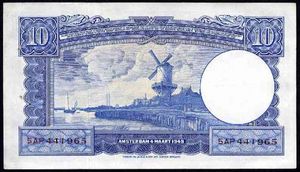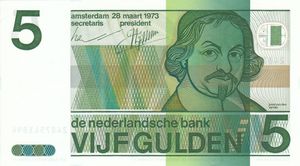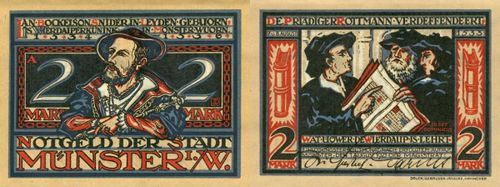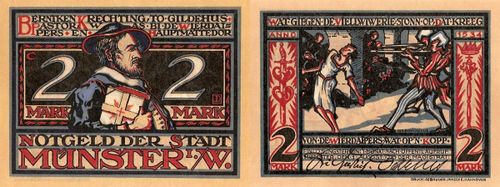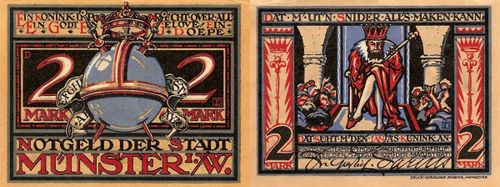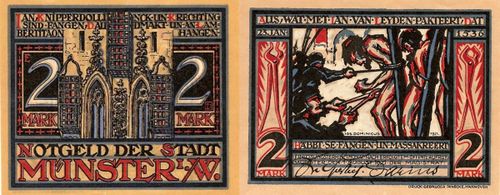Paper Money and Notgeld with Anabaptist Mennonite Themes
Introduction
Though Mennonites have rarely been political leaders they have made significant contributions or participated in historical events of several countries. Netherlands, the German Democratic Republic and the Germany City of Münster all issued paper money with Anabaptist / Mennonite themes. Money used for the payment of labour or goods is traditionally in the form of precious or semiprecious metal and shaped as coins. However, for over a thousand years paper with printed designs has been used as system of representative money. In modern times banks and nations have illustrated their paper money, banknotes, with drawings of leaders, art, historic figures or events, or national themes.
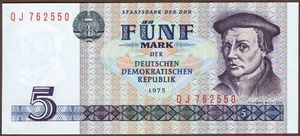
German Democratic Republic
The German Democratic Republic, (Deutsche Demokratische Republik (DDR)) also know as East Germany which existed from 1949-1990 issued a five mark banknote in 1975 with an illustration of Thomas Müntzer. This country held the revolutionary Anabapstist Müntzer in high regard. The dimensions of this note are 112x50 mm.
Netherlands
Netherlands, through its national bank, De Nederlandsche Bank, issued a number of official banknotes with illustrations connected to Mennonites. The first was in 1943 when the National Bank issued their blue 10 guilder banknote with an illustration called: "Man in a Hat." It is a reverse image of the Mennonite cloth merchant Volckert Jansz (1605 or 1610–1681) featured in Rembrandts famous painting of The Syndics (De Staalmeesters). The dimensions of this note are 142x68 mm.
In 1949 a new blue 10 guilder banknote was introduced that featured on the obverse an engraving of the painting "Tower Mill at Wijk dij Duurstede" by the Mennonite painter Jacob van Ruisdael.
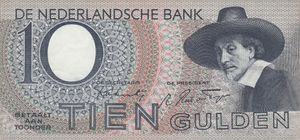 Netherlands 10 Guilder Banknote with an image of Volckert Jansz. |
In 1966 a green five guilder banknote was introduced by the national Netherlands Bank. It bore the portrait of the Mennonite poet Joost van den Vondel. These notes were green and of two different design. This design was replaced in 1973 with a more stylized version of the same green five guilder banknote. These banknote dimensions are: 136 x 76 mm.
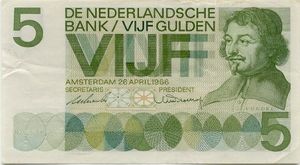 Netherlands 5 Guilder Banknote (1966) with portrait of Mennonite poet Joost van den Vondel. |
Münster Notgeld
Notgeld is the German word for "emergency money" and it was also known as "necessity money." As the First World War strained the economy of the Central Powers and Germany in particular, inflation began to disrupt their national money systems. This caused the general populous to begin hording gold, silver and even copper coinage for the value of the metal itself exceeded the coin’s denomination. With the disappearance of coinage people and businesses needed something else to fill the void just to enable normal shopping and small business transactions to be carried out. Cities and banks began printing their own paper designed Notgeld as a mutually accepted means of payment. Though Notgeld was not legal tender it did enable the county’s economy to function. Over 100,000 different examples of Notgeld were designed, printed and issued between 1918 and 1922 containing a bewildering number of illustrations. Most cities illustrated Notgeld with local historical events or figures. By late 1922 hyperinflation began to devastate Germany and other forms of emergency money began. In November 1923 Germany introduced new currency that stabilized the economy and the need for Notgeld ended.
The German City of Münster in North Rhine-Westphalia on 1 August 1921 reached into its violent historic past with the issuing of a set of five different examples of paper Notgeld currency. Münster illustrated these five Notgelds with engravings from their past of 1534 when the revolutionary Anabaptist Jan Beukelzoon, also known as John of Leiden, took power in the city and founded the only Anabaptist state. This currency was marked with the letters "A" through "E" and a very large number of each example was printed. The denomination of each was for 2 Marks and their dimensions are: 113 x 85 mm making them smaller than most modern banknotes. Interesting text was included on the notes which help to explain the illustrations. The Notgeld was printed by Gebrüder Jäneke in Hannover, and the illustrations were drawn by Josef Dominicus of Paderborn, Germany. The illustrations of Jan Beukelzoon on Notgeld "A" and of Bernt Knipperdolling on "B" are based on engravings of Heinrich Aldegrever (um 1502-1555/1561) and Jan Müller (1571-1628).
Notged A. Recto text: Ian Bockelson, Snider, in Leyden gebuoren Is Wiërdaiperkunink in Mönsterwuorn. 1534-1536: [translation = Jan Bockelson [Beukelzoon], tailor, born in Leyden, became the Anabaptist King in Münster]
Verso text: De Priädiger Rottmann verdeffendeert zu 8. August, 1533 Wat uower de Wiërdaup is lehrt: [translation = The preacher Rottmann defends what is taught about Anabaptism.]
Notgeld B. Recto text: Den Berndt Knipperdollink, Händler mit dook, de Jan van Leyden, ton Scharprichter mook: [translation = Bernt Knipperdollinck, a cloth dealer whom Jan van Leyden made an executioner.]
Verso text: De Wiërdaipers, von Raoserie vull, Schreit: Wehe! Wehe! un „Busse!“ Äs dull: [translation = The Anabaptists, full of frenzy, shout "You‘ll be sorry" and "Repent" like crazy.
Notgeld C. Recto text: Berntken Krechting, To Gildehus, was bi de Wiërdaipers en Hauptmattedor: [translation = Berntken Krechting, pastor of the Guildhouse, was the Anabaptist First Councillor.]
Verso text: Wat giegen de Viellwiwerie stonn op, Dat kreeg von de Wiërdaipers wat op'n Kopp. [translation = Whoever stood up against polygamy, received a shot in the head from the Anabaptists. (1534)]
Notgeld D. Recto text: Ein Konink op recht over all Ein Godt ein Gelove, Ein Doepe: {translation = A king rules everywhere: One god, one faith, one baptism]
Verso text: Dat m'ut'n Snider all's maken kann. Dat Süht m'den IAN däs Künink an. [translation = A tailor can do all that. Such is asked of Jan, the King.]
Notgeld E. Recto text: Ian, Knipperdollink un Krechting sind fangen, Daudmakt un an Lambertita on hangen. [translation = Jan, Knipperdollinck and Krechting were caught, tortured to death and hung from St. Lambert's tower]
Verso text: Alls, wat mat Jan van Leyden pakteert, Dat Häbbt se fangen un massakreert [translation = Everyone who agreed with Jan van Leyden was caught and massacred. 23 January 1536]
Bibliography
Standard Catalog of World Paper Money, Modern Issues, 1961-Present. Iola, Wisconsin: Krause Publications.
Web site of information: http://webgerman.com/Notgeld/Directory/M/m.htm
| Author(s) | Victor G Wiebe |
|---|---|
| Date Published | July 2014 |
Cite This Article
MLA style
Wiebe, Victor G. "Paper Money and Notgeld with Anabaptist Mennonite Themes." Global Anabaptist Mennonite Encyclopedia Online. July 2014. Web. 4 Apr 2025. https://gameo.org/index.php?title=Paper_Money_and_Notgeld_with_Anabaptist_Mennonite_Themes&oldid=128412.
APA style
Wiebe, Victor G. (July 2014). Paper Money and Notgeld with Anabaptist Mennonite Themes. Global Anabaptist Mennonite Encyclopedia Online. Retrieved 4 April 2025, from https://gameo.org/index.php?title=Paper_Money_and_Notgeld_with_Anabaptist_Mennonite_Themes&oldid=128412.
©1996-2025 by the Global Anabaptist Mennonite Encyclopedia Online. All rights reserved.
